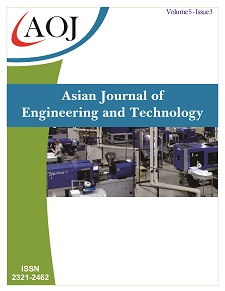Statistical Research of Intersection of Technology and Entrepreneurship to Modern Practices, Policies and Promises
DOI:
https://doi.org/10.24203/ajet.v8i3.6365Keywords:
Entrepreneurship, Innovation, Invention, Statistics. IntroductionAbstract
There are many factors affecting the relationship between entrepreneurship and technology which has not been examined and studied and this has been a daunting problem for researchers in this area. This paper seeks to identify a number of factors that deal with technology and entrepreneurship with a view to understanding the inter-correlation among the identified factors thereby making us to know the intersection between them. It will help provide an overview of the state of the art in terms of technology and offers fresh insights for entrepreneurship policy for technology.
This study employed Kendall’s Coefficient of Concordance (KCC) to rank the 32 identified variables and subsequently apply Principal Component Analysis (PCA. KCC was used to rank 32 identified variables in descending order of importance. Furthermore, the PCA was used to analyze a set of questionnaire crafted with the 32 variables and administered to knowledgeable respondents in the area. The outputs gotten from the statistical software include descriptive statistic, correlation matrix, eigenvalues, eigenvector, varimax rotated factor loadings, explained variance and factor plot, among others and thereafter interpretation was given. Result obtained unveiled five principal factors which were labeled creatively. Results obtained by KCC suggested that judges ranking were consistent. Also, PCA was indicating parsimony in data reduction from 32 variables to just five. The most influential variable by its factor loading of 0.954 is innovation. The import of this is that innovation which has the highest factor loading is the nexus between technology and entrepreneurship and should therefore be embraced.
References
T. Bailletti, “Technology Entrepreneurship”: Overview,
Definition and distinctive aspects, technology innovation management review,: pp 5- 12, February 2012.
B. Bamiro, “Engineering Capacity Building towards National Development” 21st Engineering Assembly by Council for the Regulation of Engineering in Nigeria (COREN), Abuja Nigeria, 2012.
Y.Carlisle, and E. Macmillan, “Innovation in organizations from a complex adaptive systems perspective” Emergence, complexity and organizations 8, no 1, 2-9, 2006.
W. Naude and T. Gries, “Entrepreneurship and human
development” A capability approach; Journal of Public Economics, Volume 3 issue 1, pp 216 – 224, 2011
S.Nicholas, and N. Armstrong, “Engineering entrepreneurship: Does entrepreneurship have a role in engineering education, IEE Antennas and Propagation Magazine, Vol. 45, No 1, February 2003.
S. Shane, and S. Venkataraman, ‘The Promise of
Entrepreneurship as a Field of Research’, Academy of Management Review, 25(1): pp21-26, 2000.
M. VanPraag, and P. Versloot, “What is the Value of Entrepreneurship” A Review of Recent Research, Small Business Economics, vol.29: pp351-382, 2007.
Downloads
Published
Issue
Section
License
Copyright (c) 2020 Peter O. Emereje, C. U. Okolie, Tunde B. Adeleke

This work is licensed under a Creative Commons Attribution-NonCommercial 4.0 International License.
- Papers must be submitted on the understanding that they have not been published elsewhere (except in the form of an abstract or as part of a published lecture, review, or thesis) and are not currently under consideration by another journal published by any other publisher.
- It is also the authors responsibility to ensure that the articles emanating from a particular source are submitted with the necessary approval.
- The authors warrant that the paper is original and that he/she is the author of the paper, except for material that is clearly identified as to its original source, with permission notices from the copyright owners where required.
- The authors ensure that all the references carefully and they are accurate in the text as well as in the list of references (and vice versa).
- Authors retain copyright and grant the journal right of first publication with the work simultaneously licensed under a Attribution-NonCommercial 4.0 International that allows others to share the work with an acknowledgement of the work's authorship and initial publication in this journal.
- Authors are able to enter into separate, additional contractual arrangements for the non-exclusive distribution of the journal's published version of the work (e.g., post it to an institutional repository or publish it in a book), with an acknowledgement of its initial publication in this journal.
- Authors are permitted and encouraged to post their work online (e.g., in institutional repositories or on their website) prior to and during the submission process, as it can lead to productive exchanges, as well as earlier and greater citation of published work (See The Effect of Open Access).
- The journal/publisher is not responsible for subsequent uses of the work. It is the author's responsibility to bring an infringement action if so desired by the author.


